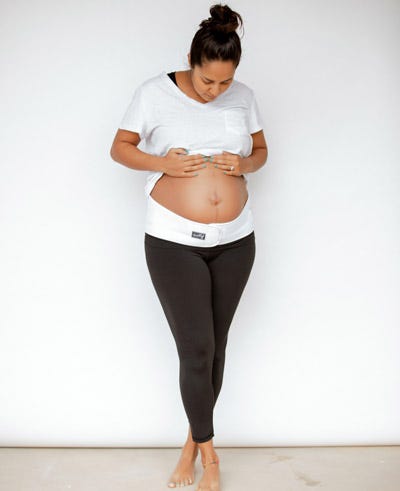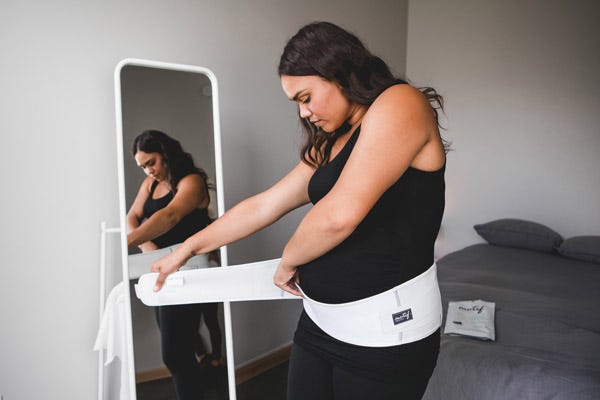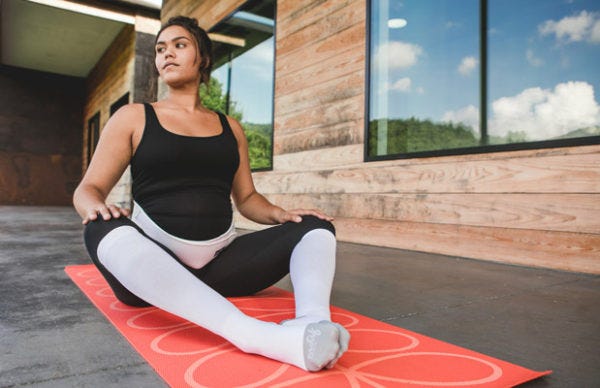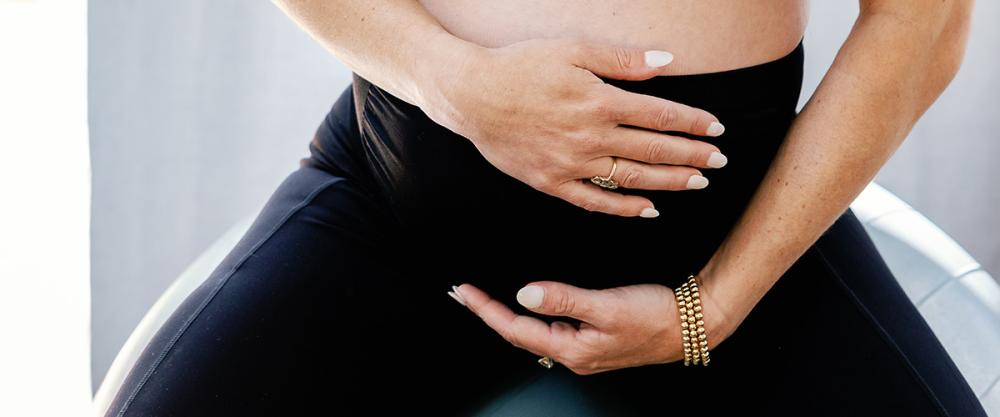Diastasis recti is the separation of the abdominal muscles down the middle of your stomach that occurs during pregnancy. This change in body structure is the body’s way of creating space for your baby to grow and develop and is considered a normal part of pregnancy.
Maybe you’re wondering how muscle separation can be normal? It’s thanks to the linea alba.
Between the two columns of your rectus abdominis muscles (the muscles that form your “six-pack”), there is a thin layer of connective tissue called the linea alba that stretches to allow this separation and then tightens back up during the postpartum to bring your abdominal muscles back together.
Every pregnant person will have their ab muscles separate during pregnancy, but diastasis recti abdominis (DRA) is typically diagnosed only if there is a separation of more than 2.7 cm that persists for more than 6 weeks postpartum. A study in the British Journal of Sports Medicine found that at 6 weeks postpartum, 60% of moms still had some separation of abdominal muscles, and 32% still had at least mild DR at 12 months postpartum.¹
How Many Women Are Diagnosed With Diastasis Recti?
All women will have some degree of muscle separation following the birth of their baby, but that doesn’t mean they will be diagnosed with DR. As mentioned earlier, the body has a system for this and often the linea alba will pull the abdominal muscles back together after the birth. DR is usually only diagnosed if the muscular separation continues beyond 6 weeks postpartum.
A study in the British Journal of Sports Medicine found that at 6 weeks postpartum, 60% of moms still had some separation of abdominal muscles, and 32% still had at least mild DR at 12 months postpartum.¹ So while it often resolves, it certainly doesn’t always resolve on its own. Good thing there’s something you can do to help!
Can You Prevent Diastasis Recti?
When you’re pregnant, there’s nothing you can do to prevent your abdominal muscles or stomach muscles from separating. Your muscles have to move apart to create enough room for your baby to grow. But that doesn’t mean to give up! Maintaining a strong and active core (abdominal muscles, pelvic floor and back muscles) during pregnancy will help your body recover after birth—and I don’t mean do lots of crunches.
In order to minimize DR, you’ll want to avoid creating unnecessary intra-abdominal pressure, both during pregnancy and in the immediate postpartum. Exercises like side planks or cat/cow poses are great for working your core in a safe and effective way.


Also, make sure you are maintaining good posture during pregnancy. Sitting up straight, bending over at the hips, and squatting to pick things up are great daily habits to keep your core muscles strong.
How Do I Know If I Have Diastasis Recti?
First of all, don’t do this if you are still pregnant or less than 2 weeks postpartum. Then, lay on the floor on your back and bend your knees slightly. Place your fingers in the center of your abdomen just above your belly button. Slightly lift your head off the ground. You should feel your abdominal muscles activate and be able to feel one of two things:
- Two rows of abdominal muscles joined by tight tissue in the middle (you won’t be able to feel between the rows of muscle)
- Two rows of abdominal muscles with a gap in between them. If you have a gap, measure it in finger widths.
Repeat these steps just below your belly button to check for separation there, too.
If you find a gap—don’t panic! This is a very common finding, especially for women who have had a baby and have not done anything to bring their muscles back together. This doesn’t have to be permanent and there is lots of great support and help available!
What you might experience if you have Diastasis Recti Abdominis
If your abdominal muscles don’t come back together in the postpartum, the most common symptom is a lingering abdominal “pooch.”
It does take time for your body to recover after giving birth, so don’t expect your pregnancy belly to be gone the next day, but if you have a pooch that remains more than 6 weeks postpartum, or you see “doming” along the midline when you do a sit-up, you might have diastasis recti. You might also notice an instability in your core muscles.
Your abdominal muscles, back muscles, and pelvic floor make up your core and when one of those systems is not working properly, it affects the functionality of the whole core, leading to aches, pains, and discomfort. If your back has to work harder to provide you with stability, you will likely have more lower back pain and aches.


If your pelvic floor is having to do more work to provide support to your body, you may notice an achy feeling in your pelvis, constipation, bloating, incontinence issues or other pelvic floor dysfunction. You can also develop a hernia, which is a tear in the linea alba that allows your organs to protrude through the abdominal wall. Hernias can be painful and can only be corrected with surgery.
How to assess yourself for Diastasis Recti and what you can do
When you are at least 2 weeks postpartum, lay on your back on the floor, bend your knees so your feet are flat on the ground, and slightly lift your head off the ground until your abdominal muscles engage. Use your fingers to gently press along the midline of your stomach and around your belly button.
You will either feel two columns of abdominal muscles joined by tight tissue (you may not even be able to get your finger in between the two muscles) or you will feel two columns of abdominal muscles with a gap in between them. If you have a gap, measure how wide it is in finger widths. A typical postpartum gap that people find is 1-3 finger widths.
If you found a gap between your muscles, don’t panic! DRA is usually only diagnosed if the gap is wider than 2 finger widths and you are more than 6 weeks postpartum.


And even if you do have DRA, there are exercises and specialists who can help you restore your core. If you have diastasis recti, here’s what you’ll want to do next:
- Avoid heavy lifting, as this can exacerbate the issue
- Practice good posture and diaphragmatic breathing. This will help you engage your abdominal muscles more often throughout the day.
See a physical therapist who can evaluate your particular situation and give you a specialized recovery plan.
Is There Anything You Can Do To Help Diastasis Recti?
Of course! Always check with your medical provider before beginning any new exercise program, but the good news is there are many personal trainers who are knowledgeable in postpartum recovery. If finding time to go to the gym is an issue, there are also some amazing online programs that you can do with minimal equipment right in your home that are geared towards helping improve or fix DR.
If you are less than 6 weeks postpartum, I recommend working on not breathing into your belly (your ribs and chest should move more with each breath and your belly should not move much at all) and maintaining good posture while you are sitting and bending over, as these simple habits encourage a strong core. Also, the use of a postpartum recovery garment during the initial postpartum period is super helpful at encouraging good posture and bringing your abdominal muscles back together.
Can you prevent DRA?
When you’re pregnant, there’s nothing you can do to prevent your abdominal muscles from separating. Your muscles have to move apart to create enough room for your baby to grow. But you can maintain a strong and active core during pregnancy, which will minimize the separation and help your body recover after birth. Exercises like side planks or cat/cow poses are great for working your core in a safe and effective way.


You’ll want to avoid heavy lifting or other activities that create intra-abdominal pressure that results in your abdomen “doming” at your midline—avoid any doming both during pregnancy and in the immediate postpartum. Also, make sure you are maintaining good posture during pregnancy. Sitting up straight, bending over at the hips, and squatting to pick things up are great daily habits to keep your core muscles strong.
References:
- Sperstad JB, Tennfjord MK, Hilde G, et al. Diastasis recti abdominis during pregnancy and 12 months after childbirth: prevalence, risk factors and report of lumbopelvic pain. British Journal of Sports Medicine 2016;50:1092-1096.








